#Ciompi
Explore tagged Tumblr posts
Link
Join a Guild---just opened!
#History#Medieval#Middle Ages#Guild#guildmaster#Journeymen#apprentice#apprenticeship#artisan#guild artisan#Femmes Sole#Ciompi#Ciompi Revolt#Harelle#laborers#Wages
0 notes
Text
Forse,semplicemente,a forza di difendersi da chi la vuole uccidere,ha cercato di sopravvivere e ha messo il cuore da parte,come in fondo facciamo tutti dopo che qualcuno decide di calpestarlo e di farlo a pezzi.
📚❤️🩹
#camy blue#silvia ciompi#le stelle non fanno rumore#leggere#lettura#buone letture#libro#libri da leggere
9 notes
·
View notes
Note
Hello. This might be bit of vague question. But how many members did guilds usually have? I mean blacksmithing guilds, in 15th or 14th century medieval England. And what factors effect the size of the guild, and to what extent? I know population, local trade, etc. Do the size really vary that much? Considering they were such structured organization, wont they have general limit to how big and small the guilds should/would be?
Guilds varied wildly in terms of numbers, depending on how specialized their trade was (not that many lawyers or doctors compared to shoemakers), and the relative size of their given industry. To give an example, the Florentine economy during the Renaissance was so organized around the textile industry that the wool guild (Arte della Lana) had 30,000 workers in their industry - many of whom sought their own independent guild during the Revolt of the Ciompi. Overall, about 9,000 residents of Florence were guild members (about a third of the population), but I don't have a breakdown by guild.
11 notes
·
View notes
Text
DE LA BUCURESTI PAN LA TIMISOARA SA DAT ZVON IN TOATA TARA STIE ROMANIA TOATA ROMANIA CA DE LA MINE PLEACA SMECHERIA BATERIE BATERIE BATERIE FOC FOC TOATE STICLELE SA RAMANA FARA DOP FIINDCA VREAU SA BEAU SA BEAU CA AM BANI DE UND SA DAU
0 notes
Text
Looking at the trend of accusations of treason being dealt with exile in Firenze (people who straight up tried to go against the Medici), then looking at the fact that even Piero degli Albizi’s execution during the government of the Ciompi happened three days after his arrests and how little sense it makes for the execution to happen how it does or to happen at all, then looking at this quote from April Blood (For those of good birth exile could be devastating, because it cut one off from friendships and roots, from the possibility to be confirmed in one’s identity every day, from the usual sources of income, forcing a half life which was more of a half death) and then crying a bit.
17 notes
·
View notes
Text
Se qualche volta quando mi pensi ti andasse di chiamarmi io sono qui così magari ci pensiamo insieme se ti va (https://contanosoloidettagli.tumblr.com/ Silvia Ciompi)
Scrivo a te, quando scrivo sui vetri appannati. (Antonio Dikele Distefano da https://jezcole.tumblr.com/)
E niente è più provocante di due sguardi che s'intendono (da https://www.tumblr.com/storminside)
“Ora ti prego stringimi tra le tue braccia perché una bocca mente anche quando bacia” Luchè (da https://www.tumblr.com/laragazzachepiangesempre)
Chiamami, interrompimi, dimmi che ti passavo per la mente (di https://nero-ne.tumblr.com/)
insistentemente ti sentivo dentro e non riuscivo più a vivere (Roberto) Se qualche volta quando mi pensi ti andasse di chiamarmi io sono qui così magari ci pensiamo insieme se ti va (https://contanosoloidettagli.tumblr.com/ Silvia Ciompi)
Scrivo a te, quando scrivo sui vetri appannati. (Antonio Dikele Distefano da https://jezcole.tumblr.com/)
E niente è più provocante di due sguardi che s'intendono (da https://www.tumblr.com/storminside)
“Ora ti prego stringimi tra le tue braccia perché una bocca mente anche quando bacia” Luchè (da https://www.tumblr.com/laragazzachepiangesempre)
chiamami, interrompimi, dimmi che ti passavo per la mente di https://nero-ne.tumblr.com/
Siamo un po tutti i prigionieri ma anche i carcerieri dei nostri pensieri (di https://www.tumblr.com/breath-of-dancing-flame)
Se qualche volta quando mi pensi ti andasse di chiamarmi io sono qui così magari ci pensiamo insieme se ti va (https://contanosoloidettagli.tumblr.com/ Silvia Ciompi)
Scrivo a te, quando scrivo sui vetri appannati. (Antonio Dikele Distefano da https://jezcole.tumblr.com/)
E niente è più provocante di due sguardi che s'intendono (da https://www.tumblr.com/storminside)
“Ora ti prego stringimi tra le tue braccia perché una bocca mente anche quando bacia” Luchè (da https://www.tumblr.com/laragazzachepiangesempre)
chiamami, interrompimi, dimmi che ti passavo per la mente di https://nero-ne.tumblr.com/
3 notes
·
View notes
Photo
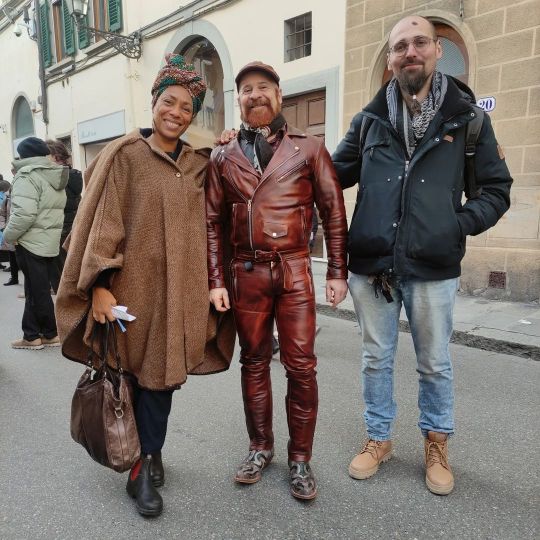
Sabato pomeriggio Il piacere di incontrarmi con Antonella Bundu e Dimitrij Palagi sempre in prima fila per i diritti #diritti #Firenze #firenzecittàaperta #sinistra #cittadinanza (presso Piazza dei Ciompi) https://www.instagram.com/p/CokeIODKR8e/?igshid=NGJjMDIxMWI=
8 notes
·
View notes
Text
youtube
Heinrich Wilhelm Ernst - String Quartet in B-Flat Major, Op. 26: II. Andante con moto e con molto tenerezza ·
The Ciompi Quartet
2 notes
·
View notes
Text
Luc Ciompi wird 95!
(Luc Ciompi – Foto: Tom Levold 2024) Heute feiert Luc Ciompi seinen 95. Geburtstag und systemagazin gratuliert von Herzen. Bereits zu seinem 90. Geburtstag haben sich im systemagazin zahlreiche Gratulanten eingefunden, um ihm Glück zu wünschen und zu seinem Lebenswerk zu gratulieren, das er über viele Jahrzehnte mit Beharrlichkeit entwickelt und erweitert hat. Mittlerweile sind wieder fünf Jahre…

View On WordPress
0 notes
Text
The revolt of the Siena workers in 1371, the Ciompi revolt in Florence in 1378, the almost simultaneous rebellion of Wat Tyler in England, and the uprisings in France about 1380 suggest a Continental wave of revolution and a greater measure of intercommunication and mutual influence, among the working classes in Western Europe, than has generally been supposed.
The Renaissance p35 by Will Durant, Simon & Schuster 1953
0 notes
Text
La fine del Mercato Vecchio

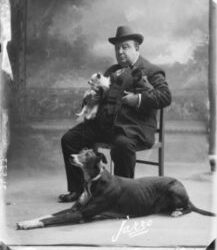
L’area del Mercato Vecchio, già dal Settecento, aveva subito un profondo e progressivo degrado architettonico, sociale ed urbanistico. Un giornalista dell'800, Giulio Piccini, detto Jarro, che a parer mio aveva il dente parecchio avvelenato, descriveva così la zona: “chi crederebbe che entro Firenze, la città molle, vezzosa, che ha per tutto levato grido di miti e dolci costumi è una Firenze dove stanno in combutta il sicario e il ladro, l'assassino negl’intervalli in cui esce di galera e il lenone, il ruffiano abietto e atroce? Siete voi andati mai in quegl’antri, in quelle tane, per que’sotterranei, dove la notte le pareti formicolano di insetti, dove il soffitto è così basso che è impossibile ad un uomo di giusta statura entrare lì senza curvarsi, e dove su putridi giacigli si scambiano gli amplessi ladri e baldracche, lordure umane, sgorganti in quegli orrendi sterquilini, dopo aver corso trabalzando per le fogne del vizio?” Jarro raccolse i risultati della sua inchiesta in un volume dal titolo “Firenze sotterranea” che uscì nel 1881 e che, con diverse edizioni fino al 1899, suscitò notevole scalpore ed ebbe notevole influenza sulle decisioni politiche che vennero prese.
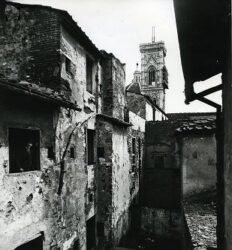
L'area del Mercato Vecchio e tutto il Vecchio Centro sino ai Camaldoli (la zona di San Lorenzo), era fin dal Settecento soggetta a continuo degrado e sin dall'occupazione napoleonica, nei primi anni dell'Ottocento, si stava pensando ad un riordinamento dell'intera zona. Nel 1835 Firenze venne investita da una grande epidemia di colera; sembra che uno dei focolai più importanti fosse scoppiato proprio nella zona, date le condizioni di degrado igienico in cui versava. Provvedimenti per risanare la zona del Ghetto erano stati studiati già ai tempi di Ferdinando II e di Cosimo III, ma non vennero mai attuati. Con la demolizione dei Camaldoli, nel 1860 circa, e con la costruzione del Mercato di San Lorenzo, le condizioni del Ghetto si aggravarono ulteriormente. Ormai gli ebrei avevano quasi totalmente abbandonato la zona, che era diventata pian piano rifugio per tutta quella popolazione emarginata di cui parlava Jarro, a cui si andavano aggiungendo gli abitanti del popolo di Camaldoli, lì trasferiti dopo la distruzione delle loro case per far posto al Mercato Centrale di San Lorenzo.
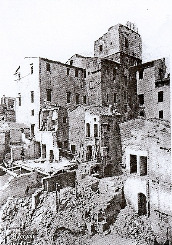
Nel 1876 il sindaco Ubaldino Peruzzi nominò una commissione per condurre un'indagine sulle condizioni dell'area del Mercato Vecchio e nel 1884 vennero iniziate le pratiche di esproprio delle abitazioni del Ghetto. Già nel 1885 tutte le 364 famiglie che lo abitavano erano state evacuate, e di esse solo 40 erano fiorentine, mentre le altre provenivano da diverse province e dall'estero. Nell'aprile 1885 veniva approvato il nuovo piano regolatore edilizio, che prevedeva l'intera ristrutturazione dell'area del Mercato Vecchio. Della commissione nominata per la demolizione degli antichi edifici facevano parte anche Corinto Corinti e Guido Carocci; alla decisione presa di abbattere tutti gli edifici tentò di opporsi soltanto il Carocci, che difese il non abbattimento di alcuni edifici.
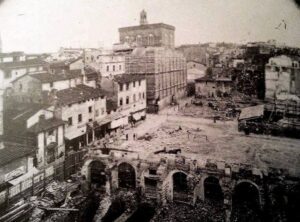
Secoli di storia di Firenze vennero cancellati in poco tempo. Vennero distrutte molte torri, come quella degli Amieri e dei Caponsacchi, e diverse chiese, come quelle di Sant'Andrea, di San Pietro Buonconsiglio, di San Tommaso, di Santa Maria in Campidoglio che erano parte della storia antica, medievale e rinascimentale di Firenze; ed anche altri edifici in cui risiedevano, ad esempio, l'Arte degli Albergatori e l'Arte dei Rigattieri. Venne distrutta la Beccheria, e la Loggia del Pesce venne smontata per accumularne i pezzi in San Marco ed essere ricostruita, quasi un secolo dopo, in Piazza dei Ciompi.

Tra le poche strutture architettoniche salvate vi fu un tabernacolo del Trecento che venne sistemato nel Palagio della Lana, il Tabernacolo di Santa Maria della Tromba. Il suo nome derivava da quello di un vicolo detto "della Tromba", ove risiedevano i "trombetti" del Comune. Era il più grande tabernacolo di Firenze, tanto che quando venne chiuso il vicolo della Tromba, venne ingrandito fino a diventare un vero e proprio oratorio, con la pittura del tabernacolo che ne decorava l'altare. Esso confinava, sul retro, con la chiesa di San Tommaso. Le demolizioni avvennero in tempi rapidissimi e in breve la piazza assunse un aspetto interamente diverso. Agli antichi edifici vennero sostituiti quelli di stile neoclassico od eclettico (definiti non senza amarezza da Telemaco Signorini “porcherie”) che ancora oggi si vedono nell’attuale Piazza della Repubblica. Venne costruito il grande edificio con i Portici, inusuali a Firenze, con l'Arcone centrale, che venne progettato da Vincenzo Micheli. Venne costruito un palazzo in stile neorinascimentale sul lato settentrionale, da allora sede della Fondiaria. A mezzogiorno venne edificato un palazzo in stile neoclassico detto poi delle Giubbe Rosse; ed altri palazzi in stile eclettico come il palazzo Trianon ed il palazzo Savoia. Nacquero anche quei famosi caffè, come il Gilli, il Paszcowski, il Gambrinus e le Giubbe Rosse, che divennero il centro della vita pubblica di Firenze.

Al centro della piazza venne sistemato un monumento a Vittorio Emanuele II, da cui prese il nome anche la piazza. Questo monumento, definito da un sonetto di Vamba “Emanuele a corpo sciorto”, nel 1915 venne trasferito nel Parco delle Cascine. Sempre negli stessi anni venne ricostruita la Colonna dell'Abbondanza con una copia della statua, e sistemata nel sito in cui ancora oggi si trova. La piazza del Mercato Vecchio, centro della vita popolare cittadina, scomparve. Venne indegnamente sostituita dalla nuova Piazza Vittorio Emanuele II, che divenne anch’essa centro della vita cittadina, non più popolare ma borghese. Nei nuovi palazzi si sistemarono la Borsa, La Fondiaria e gli uffici di molte importanti attività imprenditoriali, commerciali e finanziarie della borghesia fiorentina. Il Mercato Vecchio, centro della storia medievale e rinascimentale di Firenze e cuore della città sino all'Ottocento, scomparve definitivamente, lasciando il posto a quella nuova piazza che oggi si chiama Piazza della Repubblica.

Quella Piazza che non è mai riuscita ad entrare nel cuore di noi fiorentini, che sentiamo come un corpo estraneo – e tale è -, che niente ha a che vedere con la nostra Firenze, che ci fa rimpiangere ogni giorno quel che era e che non abbiamo potuto purtroppo conoscere. E trovo aberrante quella stomachevole scritta che campeggia sull’arco: “L'ANTICO CENTRO DELLA CITTÀ DA SECOLARE SQUALLORE A VITA NUOVA RESTITUITO”. Un pugno nello stomaco ogni volta che l’incrocio con lo sguardo. Si aprirono le porte ad una nuova era dei mercati: quella dei mercati coperti, che a Firenze iniziò con il Mercato Centrale di San Lorenzo, con quello di Sant'Ambrogio e che si protrasse fino al 1953 con la costruzione del Mercato Ortofrutticolo di Novoli che a sua volta venne inserito nel Centro Alimentare Polivalente, gestito dalla Mercafir, costruito nei primi anni ‘80.

Gabriella Bazzani Madonna delle Cerimonie Read the full article
0 notes
Text
5 Free Things to do at Duke in April 2024

April 7 — Ciompi Quartet with Min Xiao-Fen
At 4 p.m. Sunday, April 7, Duke’s Ciompi Quartet will be joined by special guest Min Xiao-Fen on the Baldwin Auditorium stage. Classically trained in China, Min is an acclaimed vocalist, composer and player of the pipa, a four-stringed lute-like instrument popular in China.
The performance, which will be livestreamed, will feature three selections composed specifically for string quartets and the pipa.

April 26 — Duke Campus Farm Community Work Day
From 1–4 p.m. on Friday, April 26, the Duke Campus Farm will hold a community work day where volunteers can work alongside the farm’s student crew and get a hands-on feel for sustainable agriculture. All are welcome, though advance registration to the event is encouraged.
Later that Friday, from 4:30–5:30 p.m., the Duke Campus Farm will hold a Land and Listen event allowing visitors to enjoy a short piece of environmental poetry and soak in some quiet time on the one-acre farm located in Duke Forest.

VISIT MY WEBSITE CLICK HERE
0 notes
Text
Le rinunce diventano cicatrici peggiori degli sbagli fatti lanciando il cuore senza paracadute nel grande casino che è la vita.
📚🪂
#camy blue#silvia ciompi#le stelle non fanno rumore#leggere libri#buone letture#libro#lettura#letture consigliate#libri da leggere
3 notes
·
View notes
Link
#AlessandroBarbero#Comunitàitaliana#cosafareaOxford#eventialondra#InigoLambertini#letteraturaitaliana#OxfordLiteraryFestival#OxfordUniversity#UniversitadiOxford
0 notes
Text
Paolo Calissano, Lorenzo Ciompi, Sara Ricci, Beatrice Luzzi e Mavi Felli diventarono ben presto gli idoli del pubblico. Se ne accorse ben presto pure Maurizio Costanzo, che spalancò le porte di Buona Domenica al cast di una soap capace in breve tempo di sfondare il muro dei 5 milioni di ascolto, arrivando al 35% di share. Personaggi insospettabili accostarono il loro nome a Vivere. Fabrizio Biggio, oggi spalla di Fiorello a Viva Rai 2, lavorò come dialoghista, mentre il cantante Kekko Silvestre e il giornalista sportivo Fabrizio Biasin sbucarono di sfuggita come figuranti.
Dall'articolo "Vivere, un quarto di secolo dalla prima puntata. Storia di una soap che ha segnato un’epoca" di Massimo Falcioni
0 notes
Text
every generation
every generation
don't chase patients
Medicine
taught how to live
Medicine
taught how to live
every generation
don't chase patients
Medicine
taught how to live
Medicine
taught how to live
Life
why not wherever
air water soil
It wasn't always right
air water soil
It wasn't always right
Life
why not wherever
air water soil
It wasn't always right
air water soil
It wasn't always right
every generation
don't chase patients
Medicine
taught how to live
Medicine
taught how to live
every generation
don't chase patients
Medicine
taught how to live
Medicine
taught how to live
Medication
thought human
from the beginning till today
try to stay healthy
from the beginning till today
try to stay healthy
Medication
thought human
from the beginning till today
try to stay healthy
from the beginning till today
try to stay healthy
every generation
don't chase patients
Medicine
taught how to live
Medicine
taught how to live
every generation
don't chase patients
Medicine
taught how to live
Medicine
taught how to live
Hard work and health both are the salvation of life
what we call medication
healthy what we call healthy
What is meant by both medication and recovery?
The Importance of Medication in Consumer Definitions ...
National Institutes of Health (.gov)
https://www.ncbi.nlm.nih.gov › articles › PMC4835236
by M Piat · 2009 · Cited by 44 — Recovery means living without medication. Recovery Means Finding Medication That Works.
As a library, NLM provides access to scientific literature. Inclusion in an NLM database does not imply endorsement of, or agreement with, the contents by NLM or the National Institutes of Health.
Learn more: PMC Disclaimer | PMC Copyright Notice
The role of medication in the recovery of mental health consumers is important. In the context of a multi-site Canadian study on the meaning of recovery, five themes related to medication and recovery emerged from qualitative interviews with 60 consumers. For these consumers, recovery meant: finding a medication that works; taking medication in combination with services and supports; complying with medication; having a say about medication; and living without medication. Findings underlined consumers’ need to communicate their concerns around medication and be supported in developing self-management strategies and more collaborative relationships with providers. The study suggests an expanded role for nursing practice in these areas.
The Importance of Medication in Consumer Definitions of Recovery from Serious Mental Illness: A Qualitative Study
Recovery from serious mental illness has emerged over the past two decades as a world-wide paradigm in mental health, challenging traditional biomedical models of care. Longitudinal studies have challenged century-long beliefs aboutmental illness as an inevitably deteriorative condition, establishing that the course of mental illness is heterogeneous and that recovery often occurs spontaneously (Ciompi, 1980; Fisher, 1999; Harding, Brooks, Ashikaga, Strauss, & Breier, 1987a, 1987b; Harding & Zahniser, 1994; Harding, Zubin, & Strauss, 1992; Markowitz, 2001; McGlashan, 1988; Ogawa, Miya, & Watarai, 1987; Pevalin & Goldberg, 2003; Tsuang, Woolson, & Fleming, 1979). Advances in psychopharmacology have led to better outcomes for persons with psychiatric disabilities, and further opened the way for new recovery-based approaches in psychiatric rehabilitation (Anthony, 2004; Calabrese & Corrigan, 2005). In this context, treatment modalities in mental health have evolved from a traditional illness/stabilization model, to community/rehabilitation models, and most recently to a recovery model, in which mental health consumers play an important role in planning services and advocating for their own needs.
While antipsychotic medication offers consumers new possibilities for stability and the self-management of symptoms (Noordsy et al., 2000), the decision to use, or not use, medication as prescribed is complex for consumers. It is important for mental health nurses to better understand the views of consumers around medication, particularly in relation to consumers’ personal meanings of recovery. This article reports consumers’ opinions on the role of medication drawn from a multi-site Canadian study on the meaning of recovery.
every generation
don't chase patients
Medicine
taught how to live
Medicine
taught how to live
every generation
don't chase patients
Medicine
taught how to live
Medicine
taught how to live
Life
why not wherever
air water soil
It wasn't always right
air water soil
It wasn't always right
Life
why not wherever
air water soil
It wasn't always right
air water soil
It wasn't always right
every generation
don't chase patients
Medicine
taught how to live
Medicine
taught how to live
every generation
don't chase patients
Medicine
taught how to live
Medicine
taught how to live
Medication
thought human
from the beginning till today
try to stay healthy
from the beginning till today
try to stay healthy
Medication
thought human
from the beginning till today
try to stay healthy
from the beginning till today
try to stay healthy
every generation
don't chase patients
Medicine
taught how to live
Medicine
taught how to live
every generation
don't chase patients
Medicine
taught how to live
Medicine
taught how to live
Translate Hindi
हर एक जमाना
मरीजों से पीछा न
दवाई
सिखाया कैसे जीना
दवाई
सिखाया कैसे जीना
हर एक जमाना
मरीजों से पीछा न
दवाई
सिखाया कैसे जीना
दवाई
सिखाया कैसे जीना
जिंदगी
हो क्यों न चाहे कहीं
हवा पानी मिट्टी
हर वक्त सहीं होता था नहीं
हवा पानी मिट्टी
हर वक्त सहीं होता था नहीं
जिंदगी
हो क्यों न चाहे कहीं
हवा पानी मिट्टी
हर वक्त सहीं होता था नहीं
हवा पानी मिट्टी
हर वक्त सहीं होता था नहीं
हर एक जमाना
मरीजों से पीछा न
दवाई
सिखाया कैसे जीना
दवाई
सिखाया कैसे जीना
हर एक जमाना
मरीजों से पीछा न
दवाई
सिखाया कैसे जीना
दवाई
सिखाया कैसे जीना
मेडिकेशन
समझे थे ह्यूमन
शुरू से आज तक
रहे स्वस्थ लिए यत्न
शुरू से आज तक
रहे स्वस्थ लिए यत्न
मेडिकेशन
समझे थे ह्यूमन
शुरू से आज तक
रहे स्वस्थ लिए यत्न
शुरू से आज तक
रहे स्वस्थ लिए यत्न
हर एक जमाना
मरीजों से पीछा न
दवाई
सिखाया कैसे जीना
दवाई
सिखाया कैसे जीना
हर एक जमाना
मरीजों से पीछा न
दवाई
सिखाया कैसे जीना
दवाई
सिखाया कैसे जीना
यत्न और स्वस्थ यह दोनों ही है जीवन की मोक्ष
यत्न जिसे हम मेडिकेशन कहते है
स्वस्थ जिसे हम आरोग्य प्राप्त कहते है
मेडिकेशन और आरोग्य प्राप्त दोनों में तात्पर्य क्या है
उपभोक्ता परिभाषाओं में दवा का महत्व...
राष्ट्रीय स्वास्थ्य संस्थान (.gov)
https://www.ncbi.nlm.nih.gov › लेख › PMC4835236
एम पियाट द्वारा · 2009 · 44 द्वारा उद्धृत - रिकवरी का मतलब दवा के बिना जीना है। पुनर्प्राप्ति का अर्थ है ऐसी दवा ढूंढना जो काम करे।
एक पुस्तकालय के रूप में, एनएलएम वैज्ञानिक साहित्य तक पहुंच प्रदान करता है। एनएलएम डेटाबेस में शामिल करने का मतलब एनएलएम या राष्ट्रीय स्वास्थ्य संस्थान द्वारा सामग्री का समर्थन या उससे सहमति नहीं है।
और जानें: पीएमसी अस्वीकरण | पीएमसी कॉपीराइट नोटिस
म���नसिक स्वास्थ्य उपभोक्ताओं की रिकवरी में दवा की भूमिका महत्वपूर्ण है। पुनर्प्राप्ति के अर्थ पर एक बहु-साइट कनाडाई अध्ययन के संदर्भ में, 60 उपभोक्ताओं के साथ गुणात्मक साक्षात्कार से दवा और पुनर्प्राप्ति से संबंधित पांच विषय सामने आए। इन उपभोक्ताओं के लिए, पुनर्प्राप्ति का अर्थ है: ऐसी दवा ढूंढना जो काम करे; सेवाओं और सहायता के संयोजन में दवा लेना; दवा का अनुपालन; दवा के बारे में कुछ कहना; और बिना दवा के रह रहे हैं। निष्कर्षों ने रेखांकित किया कि उपभोक्ताओं को दवा के बारे में अपनी चिंताओं के बारे में बताना चाहिए और स्व-प्रबंधन रणनीतियों और प्रदाताओं के साथ अधिक सहयोगात्मक संबंध विकसित करने में उनका समर्थन करना चाहिए। अध्ययन इन क्षेत्रों में नर्सिंग अभ्यास के लिए एक विस्तारित भूमिका का सुझाव देता है।
गंभीर मानसिक बीमारी से उबरने की उपभोक्ता परिभाषाओं में दवा का महत्व: एक गुणात्मक अध्ययन
गंभीर मानसिक बीमारी से उबरना पिछले दो दशकों में मानसिक स्वास्थ्य में एक विश्वव्यापी प्रतिमान के रूप में उभरा है, जो देखभाल के पारंपरिक बायोमेडिकल मॉडल को चुनौती दे रहा है। अनुदैर्ध्य अध्ययनों ने मानसिक बीमारी के बारे में शताब्दी-लंबी मान्यताओं को एक अनिवार्य रूप से खराब करने वाली स्थिति के रूप में चुनौती दी है, यह स्थापित करते हुए कि मानसिक बीमारी का कोर्स विषम है और रिकवरी अक्सर अनायास होती है (सियोम्पी, 1980; फिशर, 1999; हार्डिंग, ब्रूक्स, अशिकागा, स्ट्रॉस और ब्रेयर) , 1987ए, 1987बी; हार्डिंग और ज़ाहनिज़र, 1994; हार्डिंग, ज़ुबिन, और स्ट्रॉस, 1992; मार्कोविट्ज़, 2001; मैकग्लाशन, 1988; ओगावा, मिया, और वाताराई, 1987; पेवलिन और गोल्डबर्ग, 2003; त्सुआंग, वूलसन, और फ्लेमिंग, 1979). साइकोफार्माकोलॉजी में प्रगति ने मानसिक विकलांगता वाले व्यक्तियों के लिए बेहतर परिणाम दिए हैं, और मनोरोग पुनर्वास में नए पुनर्प्राप्ति-आधारित दृष्टिकोणों के लिए रास्ता खोल दिया है (एंथनी, 2004; कैलाब्रेसे और कोरिगन, 2005)। इस संदर्भ में, मानसिक स्वास्थ्य में उपचार के तौर-तरीके पारंपरिक बीमारी/स्थिरीकरण मॉडल से लेकर समुदाय/पुनर्वास मॉडल और हाल ही में एक पुनर्प्राप्ति मॉडल तक विकसित हुए हैं, जिसमें मानसिक स्वास्थ्य उपभोक्ता सेवाओं की योजना बनाने और अपने स्वयं के लिए वकालत करने में महत्वपूर्ण भूमिका निभाते हैं। जरूरत है.
जबकि एंटीसाइकोटिक दवा उपभोक्ताओं को स्थिरता और लक्षणों के स्व-प्रबंधन के लिए नई संभावनाएं प्रदान करती है (नोर्डसी एट अल।, 2000), निर्धारित दवा के उपयोग या उपयोग न करने का निर्णय उपभोक्ताओं के लिए जटिल है। मानसिक स्वास्थ्य नर्सों के लिए दवा के बारे में उपभोक्ताओं के विचारों को बेहतर ढंग से समझना महत्वपूर्ण है, विशेष रूप से उपभोक्ताओं के पुनर्प्राप्ति के व्यक्तिगत अर्थों के संबंध में। यह लेख पुनर्प्राप्ति के अर्थ पर एक बहु-साइट कनाडाई अध्ययन से ली गई दवा की भूमिका पर उपभोक्ताओं की राय बताता है।
हर एक जमाना
मरीजों से पीछा न
दवाई
सिखाया कैसे जीना
दवाई
सिखाया कैसे जीना
हर एक जमाना
मरीजों से पीछा न
दवाई
सिखाया कैसे जीना
दवाई
सिखाया कैसे जीना
जिंदगी
हो क्यों न चाहे कहीं
हवा पानी मिट्टी
हर वक्त सहीं होता था नहीं
हवा पानी मिट्टी
हर वक्त सहीं होता था नहीं
जिंदगी
हो क्यों न चाहे कहीं
हवा पानी मिट्टी
हर वक्त सहीं होता था नहीं
हवा पानी मिट्टी
हर वक्त सहीं होता था नहीं
हर एक जमाना
मरीजों से पीछा न
दवाई
सिखाया कैसे जीना
दवाई
सिखाया कैसे जीना
हर एक जमाना
मरीजों से पीछा न
दवाई
सिखाया कैसे जीना
दवाई
सिखाया कैसे जीना
मेडिकेशन
समझे थे ह्यूमन
शुरू से आज तक
रहे स्वस्थ लिए यत्न
शुरू से आज तक
रहे स्वस्थ लिए यत्न
मेडिकेशन
समझे थे ह्यूमन
शुरू से आज तक
रहे स्वस्थ लिए यत्न
शुरू से आज तक
रहे स्वस्थ लिए यत्न
हर एक जमाना
मरीजों से पीछा न
दवाई
सिखाया कैसे जीना
दवाई
सिखाया कैसे जीना
हर एक जमाना
मरीजों से पीछा न
दवाई
सिखाया कैसे जीना
दवाई
सिखाया कैसे जीना
0 notes